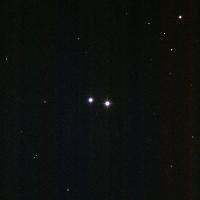Winnecke 4
Winnecke 4 (also known as Messier 40 or WNC 4) is an optical double star consisting of two unrelated stars in the constellation Ursa Major.
 Winnecke 4 double star | |
| Observation data Epoch J2000.0 Equinox J2000.0 | |
|---|---|
| Constellation | Ursa Major |
| A | |
| Right ascension | 12h 22m 12.5278s[1] |
| Declination | +58° 4′ 58.539″[1] |
| Apparent magnitude (V) | |
| B | |
| Right ascension | 12h 22m 18.9989s[1] |
| Declination | +58° 5′ 10.364″[1] |
| Apparent magnitude (V) | |
| Characteristics | |
| A | |
| Spectral type | K0 III[2] |
| B | |
| Spectral type | G0 V[2] |
| Astrometry | |
| A | |
| Parallax (π) | 2.87 ± 0.24[1] mas |
| Distance | 1,140 ± 100 ly (350 ± 30 pc) |
| Absolute magnitude (MV) | +0.88[2] |
| B | |
| Parallax (π) | 7.13 ± 0.24[1] mas |
| Distance | 460 ± 20 ly (140 ± 5 pc) |
| Absolute magnitude (MV) | +4.0[2] |
| Details | |
| A | |
| Mass | 1.1[2] M☉ |
| B | |
| Mass | 1.2[2] M☉ |
| Other designations | |
| A: HD 238107, SAO 28353 | |
| B: HD 238108, SAO 28355 | |
| Database references | |
| SIMBAD | data |
WNC 4 was discovered by Charles Messier in 1764 while he was searching for a nebula that had been reported in the area by Johannes Hevelius. Not seeing any nebulae, Messier catalogued this double star instead. It was subsequently rediscovered by Friedrich August Theodor Winnecke in 1863, and included in the Winnecke Catalogue of Double Stars as number 4. Burnham calls M40 "one of the few real mistakes in the Messier catalog," faulting Messier for including it when all he saw was a double star, not a nebula of any sort.[3]
In 1991 the separation between the components was measured at 51.7", an increase since Messier's time. Data gathered by astronomers Brian Skiff (2001) and Richard L. Nugent (2002) strongly suggested that this was merely an optical double star rather than a physically connected system.[2] In 2016, parallax measurements from the Gaia satellite showed that the two stars involved (HD 238107 and HD 238108) are unrelated,[4] confirming the previous suggestion by Skiff and Nugent. As measured by Gaia, the two stars are 350±30 pc and 140±5 pc distant, so one is over twice as far as the other.[4]
References
- Gaia Collaboration; Brown, A. G. A; Vallenari, A; Prusti, T; De Bruijne, J. H. J; Mignard, F; Drimmel, R; Babusiaux, C; Bailer-Jones, C. A. L; Bastian, U; Biermann, M; Evans, D. W; Eyer, L; Jansen, F; Jordi, C; Katz, D; Klioner, S. A; Lammers, U; Lindegren, L; Luri, X; O'Mullane, W; Panem, C; Pourbaix, D; Randich, S; Sartoretti, P; Siddiqui, H. I; Soubiran, C; Valette, V; Van Leeuwen, F; et al. (2016). "Gaia Data Release 1. Summary of the astrometric, photometric, and survey properties". Astronomy & Astrophysics. 595: A2. arXiv:1609.04172. Bibcode:2016A&A...595A...2G. doi:10.1051/0004-6361/201629512.
- Nugent, Richard L (2002). "The Nature of the Double Star M40". Journal of the Royal Astronomical Society of Canada. 96: 63. Bibcode:2002JRASC..96...63N.
- Robert Burnham (1978). Burnham's Celestial Handbook: An Observer's Guide to the Universe Beyond the Solar System. Courier Corporation. p. 1982. ISBN 978-0-486-23673-5.
- Merrifield, M. R; Gray, M. E; Haran, B (2017). "Gaia Shows that Messier 40 is Definitely Not a Binary Star". The Observatory. 137: 23. arXiv:1612.00834. Bibcode:2017Obs...137...23M.
External links

- SEDS: Messier Object 40
- Messier 40 CCD LRGB image with 2 hrs total exposure
- Sir Patrick Moore; Mike Merrifield; Pete Lawrence. "M40 – Optical Double Star". Deep Sky Videos. Brady Haran.
- Winnecke 4 on WikiSky: DSS2, SDSS, GALEX, IRAS, Hydrogen α, X-Ray, Astrophoto, Sky Map, Articles and images
